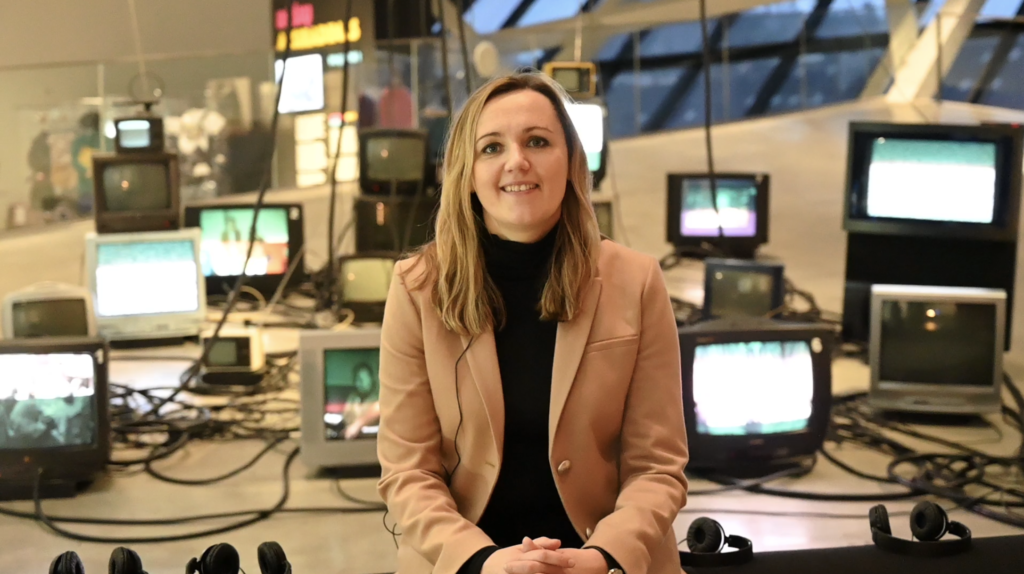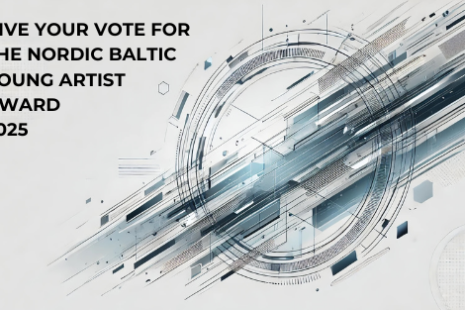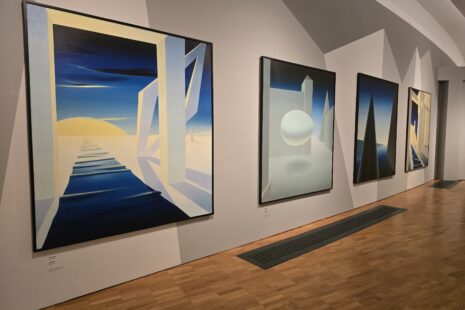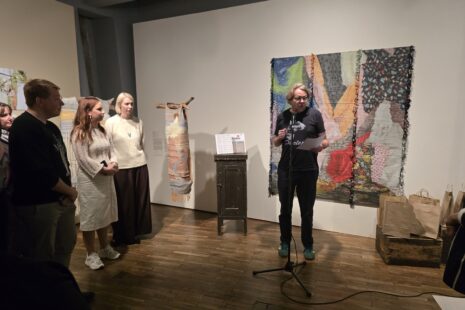MO Museum was opened in October, 2018. Since then, it has welcomed already 300 787 visitors, of whom 210 805 visited in 2019. The 15mln EUR fully furnished and equipped building is recognised for its remarkable architecture, designed by Daniel Libeskind.
What exactly is MO Museum and how does it differ from other art museums?
The Museum is a personal initiative of Lithuanian scientists and philanthropists Danguolė and Viktoras Butkus. Today one of the largest Lithuanian private collections holds more than 5000 modern and contemporary pieces containing major Lithuanian artworks from the 1960s to this day, officially recognized as being of “national significance.”
Since its opening on October 18th, 2018 MO has become an excellent place to spend free time. We took a direction to be a museum for general public, meaning absolutely everyone, offering two major thematic exhibitions per year. We want to change certain behavioural patterns and introduce the museum as part of daily life – you to go to exhibition with your friends or family, talk about it, discuss the ideas – just as people go to cinema or theatre. We bring on subjects that play a huge role in today´s society – like the last exhibition “Animal – Human – Robot”.
Holding MO debates and talks, we have invited scientists, writers, psychologists, anthropologists, historians to talk and analyze topics of exhibitions from different angles, showing that art is a way to speak about contemporary world. We really want to be an interdisciplinary hub for human, social and cultural interaction.
We also feature film screenings, educational activities, concerts and various events geared to all age groups. We have Family Sundays where the museum is full of children and parents, who found a way to spend time together. It took time and effort and a lot of communication but now people are coming.
So, you believe that the function of a museum has conceptually changed?
I believe that a museum should be a place where people can spend time and be in dialogue with family and friends or with oneself.
The role of the museum is to help make that dialogue happen. One trigger may be putting art into certain context, showing how it relates with other fields. We tend to see that people may be interested in literature, theatre, but still keep the distance from contemporary art.
So, we thought why shouldn´t we invite people who already have their audience – like theatre director – to see arts? We started the event series “Date with an artwork” where the dater is a known public figure such as a singer or theatre director and the person chooses the art piece, which becomes the starting point for the conversation. We want to share this experience with audience showing how one can relate to an artwork..
Our founder Viktoras Butkus has noticed that our society doesn’t know much about the Lithuanian art scene from 60s to nowadays. It takes time for things to change, but up until now, it’s quite promising.
A private museum of this scale is quite unique in our region. Was it the original plan or did the physical output evolve in progress?
As I mentioned before, our founders Danguolė and Viktoras had already established one of the largest art collections of over 5000 pieces. They reckoned that this endeavor would be really meaningful if it has impact on society. Thus, first of all they started its digitalization and it was made open and accessible in Lithuanian and in English for professionals as well as to the general audience. Also, around 30 books on art education were published..
Turning to the issue of museum building, firstly there was a plan to have it next to the National Gallery of Art as a project of private and state partnership, but it did not work out. The second idea was to involve private investment and operate the museum together with hotel or offices. But a museum needs spaces of height and special climate which is too expensive to work with something that relies on return on investment. Finally, it was decided that there is no space for compromises. In 2015 Viktoras Butkus met architect Daniel Libeskind and by the end of that year we had a project proposal, which the founders liked straight away.

Building the MO Museum. Photo by Norbert Tukaj
Libeskind is known for his very modern and sharp architecture. How does it function in everyday museum life?
At first, I was a bit anxious how our mission of openness would work with modern and sharp architecture. Nevertheless, Daniel Libeskind is a master whose architecture has unique atmosphere. He listened very carefully what kind of place we wanted to create and due to that the museum has had an inviting atmosphere and open character from the beginning.
In addition to that, the task for the architect was to make the building as flexible as possible to hold various exhibitions, events and functions. So, now we can change the lightning, move walls and so on.
For example, the slope in the main exhibition hall is a real challenge for curators, but at the same time it forces the creativity. Also, the space is not just a simple rectangular which gives us the advantage and opportunity to be creative. In spring we will have an exhibition by multi-media artist Saskia Boddeke and a prominent film director Peter Greenaway, who agreed to work with us namely because of these interesting spaces created by Libeskind.
Let´s not forget the famous staircase of MO Museum…
Yes, the spiral staircase is one of the key elements that the museum is known for. This was the first time Libeskind designed a circular staircase. Though I have to admit that it was a real headache finding a company who would be able to execute the stair project. Finally, our construction company built the stairs themselves.
By the way, Daniel Libeskind mentioned that although being one of the smallest, MO is one of his most favorite projects.
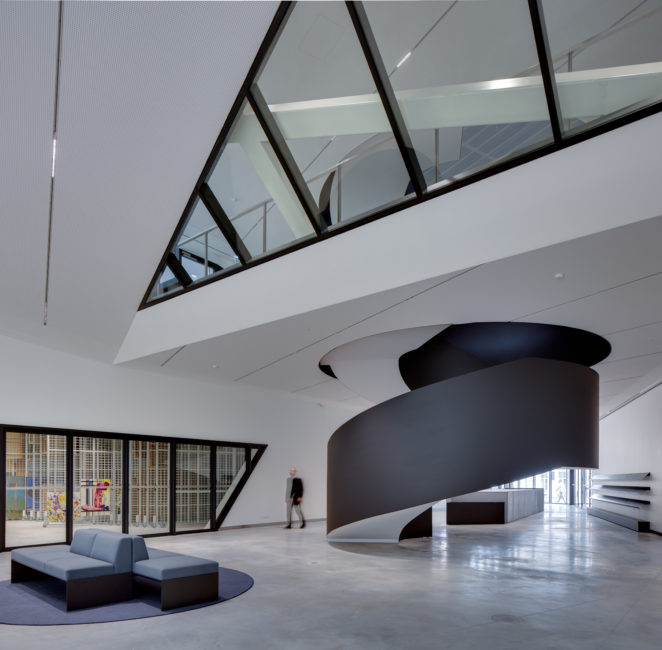
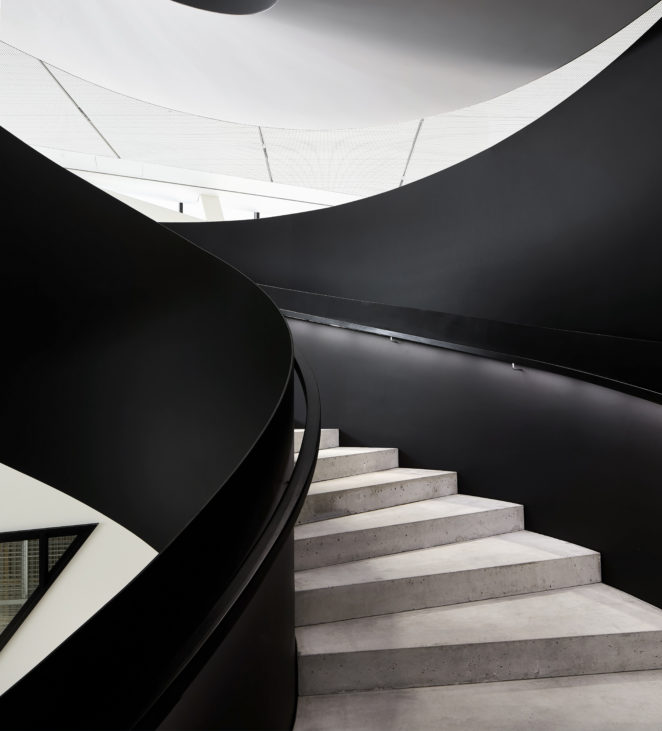
Mo Museum staircase, photo by Norbert Tukaj
I see that the museum is very popular today. How did you manage to make the audience interested?
Our motto was that everyone is welcome. If you like art, you are welcome. If you don`t like art, you are still welcome. “Have your own opinion” was our advertising slogan. Nobody can have an opinion without seeing it. And many people came – even for the first time in their lives.
Your marketing and communication has been a success. Can you tell us more about it?
First, we focused on advertising in social media – campaigns on Facebook and Instagram. Today we are a number one art institution in the Baltics on Facebook and Instagram.
Then we invited Vilnius Uber and Bolt drivers to visit the exhibition before public opening and we literally had to stop the registration when the maximum number of visitors filled up in no time.
We saw them as a communication channel as they would pass on their experience to people visiting Vilnius. Secondly – everyone is welcome and taxi drivers can find something interesting as well. We shot a video footage of the event where they really opened up and some admitted being the first time in a museum and everyone really enjoyed the experience.
With advertising we employed different solutions, I will offer some examples. We took paintings and added comics dialogue about the topic. Like abstract painting where the comics bubble is saying “It`s like me yesterday” followed by an answer bubble replying “Less party, John!”. Our message was that it is okay if you feel dizzy looking at an abstract painting, there is nothing wrong in it. Though there was some skepticism about combining art and simple language.

Fragment from MO Museum advertisement
– That is often the case with me
– Less party, Jonai
You have also received critics by the traditional art world for being not serious enough. What is your opinion on that?
Today we all face situation of everyone being in a hurry and suffering from lack of time. It is a challenge to make general audience, not limiting the museum for art professionals, to come and enjoy museum and art, let alone inspire them to come back. We work along with different art historians, curators and copywriters to make the museum and the content attractive.
The reviews show that this has worked – people are saying they were not fans of art or museums before, but now their attitude had changed after visiting the current exhibition.
So, I feel that we are doing something right, something is changing. This exhibition is open until the end of February and we have already had over 100 000 visitors which is a record number in Lithuania. I actually believe we are gaining a momentum in bringing the relevancy of art back into society.
An inspiring environment calls for dedicated staff. How many people are working in MO?
We started with 7 people and now we have 23 permanent employees with front desk people. We also have freelancers for education programs and guides. In addition, we have 100 volunteers who work for 6 months after which we announce a new open call. Today we have 250 people applying and we accept less than 100, as there is already an existing body of permanent volunteers. Fun fact – starting in 2012, I was the first volunteer working for what today is this museum!
How involved the founders are in museum everyday life?
They are not involved in everyday life and administrative matters, but we have regular monthly meetings. Also, the whole program and exhibitions are coordinated with them.
The museum is a huge investment. How do you assess the self-sufficiency in a long term?
The founders expect us to be a financially self-sustainable institution in terms of paying its bills and wages. We are still working on the financial closure of the year, but the budget for 2019 is approximately 1 960 000 eur. For now, 50% comes from tickets and the rest we have to fundraise: around 16% through state grants, which we are applying for and that requires a lot of administration, around 15-20% comes from the private sector sponsorship and the rest should come through different our activities such as shop and rent.
Lastly, tell us more about Lithuanian art scene. How do you see it?
We have a very promising and strong young generation of artists.
This year we won the Venice Biennale’s Golden Lion, until this year already 4 special mention awards were celebrated, so this helps to describe that Lithuania has a quite vivid art scene. There are strong young artists like Emilija Škarnulytė, who won the Future Generation Art Prize 2019, Robertas Narkus who has just returned from the residency at Delfina Foundation, Augustas Serapinas, who was the youngest artists at last year Venice Biennale curated exhibition, Indrė Šerpytytė, who presented side performances at last year Venice Biennale .
In terms of visiting, I recommend The National Gallery of Art, Contemporary Art Center CAC. In Kaunas we have M. K. Čiurlionis National Art Museum – it’s also an important institution presenting the masterpieces by Čiurlionis. Also, I would recommend the gallery crawl mentioning Kairė-dešinė, Meno Niša, Vartai, Rooster Gallery just as few examples
ArtVilnius Fair in the first week of June brings a number of international galleries each year to Lithuania.

